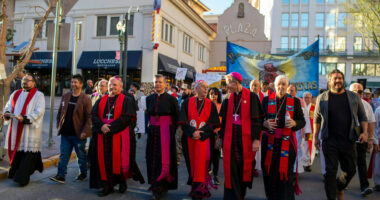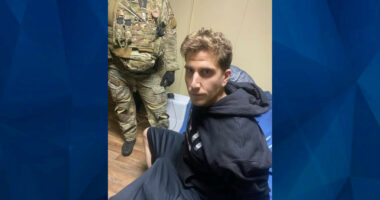
Let’s examine why Saudi Arabia’s Islamists are so aroused over the U.S. Supreme Court’s 6-3 ruling by June that using public money to fund religious madrassas is perfectly fine. The court took on the case last week from Oklahoma, where an online Catholic school, St. Isidore of Seville, but really more of 7501 NW Expressway in Oklahoma City, across from Home Depot and the Mattress Firm Clearance Center, sued after it was denied a charter and tax dollars.
 The outcome is foretold on a court that interprets English rather like J.P. Morgan wanted his lawyers to interpret the law: “I don’t know as I want a lawyer to tell me what I cannot do. I hire him to tell me how to do what I want to do.” Let there be might: in the holy hands of our college of cardinals (six of the Supreme Court justices are Catholic, five of them nominated by Republicans sent by God), “shall make no law respecting an establishment of religion” becomes “shall make no law preventing a preference for religion,” preferably Christian.
The outcome is foretold on a court that interprets English rather like J.P. Morgan wanted his lawyers to interpret the law: “I don’t know as I want a lawyer to tell me what I cannot do. I hire him to tell me how to do what I want to do.” Let there be might: in the holy hands of our college of cardinals (six of the Supreme Court justices are Catholic, five of them nominated by Republicans sent by God), “shall make no law respecting an establishment of religion” becomes “shall make no law preventing a preference for religion,” preferably Christian.
Wahhabism, interchangeably identified with Salafism, is the state religion in Saudi Arabia. Wahhabism is the most puritanical, uncompromising form of Sunni, or any, Islam, though like the ayatollahs’ version of Shiitism, it has about as many echoes in the Koran as a clucking chicken in Azerbaijan does in the Grand Canyon. Its most familiar approximation to anything Christians might know–or long for if you’re JD Vance–is the terror regime of the Catholic church’s Medieval period.
Wahhabism considers women subhuman, forbids the public exercise of any religion but its own, executes gays, adulterers and apostates, and gave us Osama bin Laden, Sheikh Omar and Abu Yusif (the ISIS leader who never managed his 15 minutes of fame because his mass murders weren’t televised.) So Wahhabism today is closest to the doctrines of the Taliban and ISIS.
Since the 1970s and with the direct support of the Saudi regime Wahhabis launched a splurge of madrassa-building across the globe, including in the United States. Culver City, Calif., was famous for a Wahhabi school attached to the still-active King Fahd Mosque, named for the Saudi king who ruled and consorted with every American president from Reagan to the second Bush. If I sound Islamophobic here, I don’t mean to be so exclusionary.
Private religious schools have a longer tradition than public schools in the United States. Nothing wrong with that. It’s how Harvard started. Its first president was the Puritan-turned Baptist minister Henry Dunster (later fired and tried refusing to baptise his child). Innumerable little Harvards, Muslim ones among them, dot the land, their quality of education often superior to anything public and undiminished by whatever religious frills drives the curriculum. I was raised by Jesuits. Their corporal violence, molesting perversions and doctrinal absurdities aside, they did a pretty good job. We would not necessarily want a land without religious schools.
There are limits. Our founders recognized them. One cleric’s religion is another’s cult. Anyone can with time, force or marketing conjure enough legitimacy out of any sectarian invention. It should not be the role of government to patent one and not another. The founders had a few millennia’s killing fields to suggest that staying out of the fray altogether is best.
So we got “Congress shall make no law,” the clause Thomas Jefferson cemented on American society with the great metaphor of the church-state wall. No, it’s not in the Constitution. But what’s in the Constitution is more explicit, as Supreme Court Justice Hugo Black–a stricter constructionist than Scalia or Thomas–put it in his reading of the First Amendment: “No law means no law.” That wall, he wrote, “must be kept high and impregnable. We could not approve the slightest breach.”
Black wrote that line in a 1947 case from New Jersey, defending a state law authorizing the reimbursement of parents for bus fares paid by students attending either public or Catholic schools. As long as public money did not end up in the pockets of religious schools, that the payments were blind to the type of schools the students attended, and that a public benefit was the goal–in this case, the safety of students–it was legal. All conditions had to be met.
Even so, the court split 5-4. Justices Robert Jackson and Felix Frankfurter blamed the majority of “giving the clock’s hands a backward turn” by circumventing the First Amendment’s prohibition, which they said applied to a “subsidy, bonus or reimbursement.”
Keep that case in mind: Everson v. Board of Education. Come June, this Supreme Court, drawing on the kind of cherry-picking sophistry and mis-history Scalia applied to fabricate the Second Amendment’s individual right to bear arms in the 2008 Heller decision, will cite Everson as one of its precedents to defend direct payments to charter school. The court majority will simply delete some of the conditions Black required.
We’ve been on this slippery slope since the mid-Reagan years. Surely you remember the Saturday in August when Reagan triggered a Soviet nuclear alert after joking, as he was doing a sound check for his weekly radio address, that he’d signed legislation outlawing the Soviet Union, and the bombing would start in five minutes. Forgotten is his actual address, when he spoke of signing legislation to allow religious groups to use public schools to meet after hours. It seemed like an innocuous, even logical decision. The court’s 1947 minority would not have approved for the same reason that it had dissented in the bus fare case. The Trojan horse looked unthreatening, even elegant. But there was no stopping its ultimate intentions once let in.
The assault has been relentless and fabulously successful. In 2002, the Supreme Court in a 5-4 decision reduced the church state-wall to something like the rustic remnants of Hadrian’s Wall when it legalized subsidizing parents’ tuition at private religious schools with public money. The swindle has since been euphemistically dressed up as “vouchers,” as if you were getting a free Pepsi at a baseball game, or by that favorite nom de guerre of the public school demolition movement, “school choice.”
Our own Paul Renner saw no reason to wait anymore two years ago when he enacted the biggest plunder of public schools in Florida’s history by taking a limited “voucher” program and opening it to any and all students. Even children of millionaires now qualify for an $8,000-per-student per-year subsidy of taxpayer dollars to attend private school or home school. No question asked. No standards required. School districts, ours among them, have been hemorrhaging students. Fly by night schools have been mushrooming to exploit their share of the racket.
Florida, like a dozen other states and many more lining up to offer “universal vouchers,” is far ahead of the Oklahoma charter case. But justices will cite the voucher movement as another justification to extend the grace of public money to charters. What can go wrong? Now you see why Saudi Arabia’s Wahhabists are licking their chops. They don’t have to put up their own money anymore to spread their Salafism in the heart of the Great Satan’s land. They can make us pay for it.
I doubt we would be having this debate if the organization seeking public money in the Oklahoma case were not a Catholic school with a saint for a mascot but a madrassa pushing the grim tenets of Salafist Islam, a K-8 project of Central Florida Wiccan and Pagans United, or the Satanic Temple’s Florida chapter looking to open Dante’s Inferno Academy for Underprivileged Devils right next to City Repertory Theatre at City Marketplace.
By the end of June, when the Supreme Court rules on this case, it will do exactly that, and what remains of that once sturdy and noble wall between church and state will be blown away as by a Salafist’s IED. Next stop: restoring prayer in schools. In the name of the father, the son and the holy subsidies. Or as our Saudi friends would croon, Allahu Akbar.
![]()
Pierre Tristam is the editor of FlaglerLive. A version of this piece airs on WNZF.








